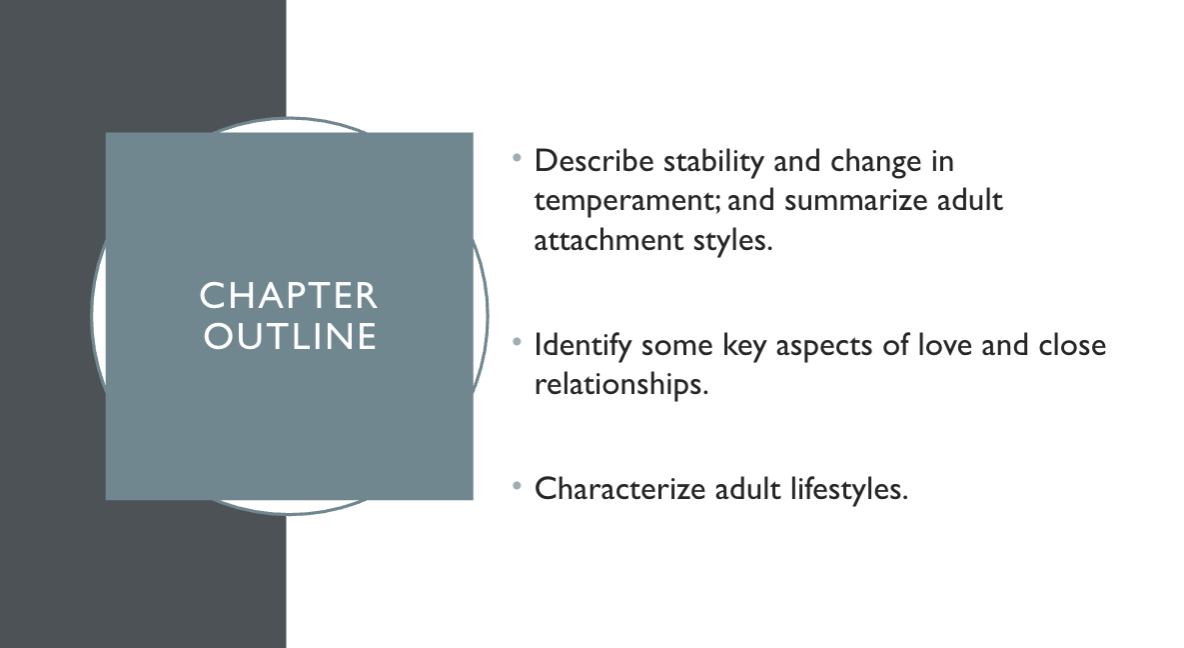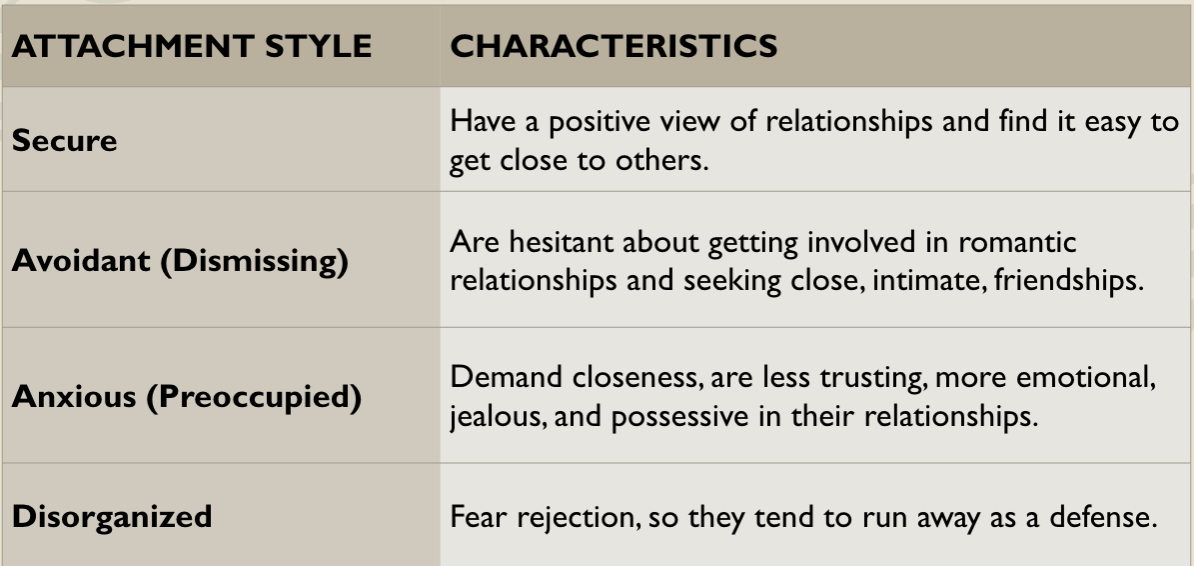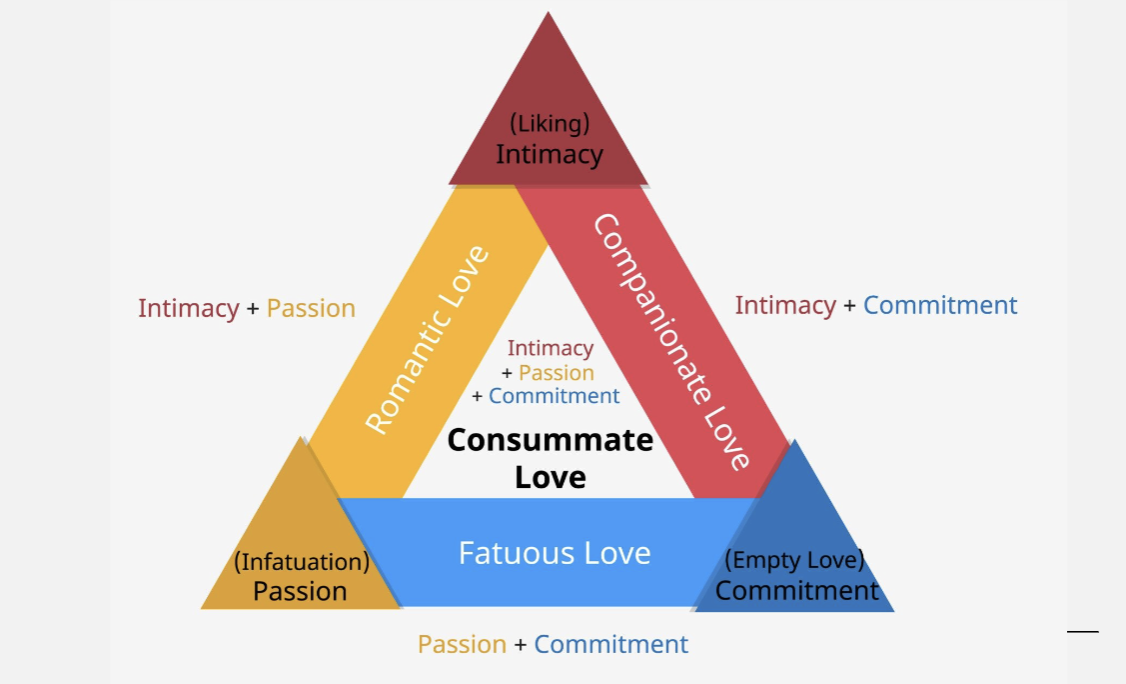Chapter 14
Socioemotional Development in Early Adulthood

Stability and Change
For adults, socioemotional development revolves around adaptively integrating our emotional experiences into enjoyable relationships with others.
Research shows that the first 20 years of life are meaningful in predicting an adult’s socioemotional well-being.
Experiences in early adulthood are also important in determining what the individual will be like later in adulthood.
Changes in socioemotional characteristics are less noticable when the time between measurements is short.
Measures of self-esteem between the ages of 25 and 30 will seem stable
Measures of self-esteem between the ages of 15 and 30 might show a more noticeable difference.
Temperament
Temperament is an individual’s behavioral style and characteristic emotional responses.
In early adulthood, people tend to have fewer emotional mood swings than they did in adolescence.
They become more responsible and engage in less risk-taking behaviors
Childhood temperament is believed to be linked to adult personality.
E.g., children who were highly active at age 4 were likely to be very outgoing at age 23
Personality and Temperament in Research
Easy and difficult temperament
Children who has an easy temperament at 3 to 5 years were well adjusted young adults. Those with difficult temperament at 3-5 were not well adjusted in emerging adulthood.
Inhibition
Infants with higher inhibition at 14 months become more reserved and introverts adults with lower social functioning at age 26
Increased trajectory of shyness was linked to social anxiety, mood disorders, and substance use in adulthood.
Emotional regulation
High emotionality at age 6 is associated with depression in emerging adulthood. Emotion dysregulation in 5th graders was linked to having violent behavioral responses at 22 years of age.
Attachment
Like temperament, attachment appears during infancy and plays an important part in socioemotional development
Although relationships with romantic partners and friends differ from those with parents, research has shown that adult attachment patterns reflect childhood and adolescent attachment
Infants whoa re securely attached at 1 year of age were securely attached 20 years later in their adult relationships
They were more stable in romantic relationships and reported stronger bonds with friends
Adult Attachment Styles

Relationship Development
Close relationships are those that are important, interdependent, and long lasting
Familial relationships
Friendships
Work relationships
Romantic relationships
These relationships can produce intense feelings that are both:
Positive - passion, caring, concern
Negative - rage, jealousy, despair
This is referred to as the paradox of close relationships
First Impressions
Three factors underlie initial attraction between strangers:
Proximity - people are more likely to become involved with those that are geographically close
Familiarity - positive feelings toward a person are increased the more often we see them
Physical attractiveness - people are more likley to interact with those they deem attractive
This is the least important factor, and recent research shows it is often over ranked by kindness, humor, and intelligence.
Building a Relationship
there are 2 factors that affect the viability of relationships:
Reciprocal liking - liking those who show they like you
Similarity - we are drawn to those with similar qualities, values, interests.
Once a relationship has been established, it requires active maintenance to sustain the desired quality of the relationship
Triangular Theory of Love
This theory states that all loving relationships are comprised of some combination of 3 components:
Intimacy - warmth, closeness, and sharing private thoughts/feelings
Passion - intense feelings (positive and negative), including sexual desire
Commitment - the decision and intent to maintain a relationship in spite of difficulties and costs that may arise
There are 8 types of relationships that can result from the presence, or absence, of each of the 3 components

Falling Out of Love: Why relationships end
Premature commitment
Ineffective communication and conflict management skills
Becoming bored with the relationship
Availability of a more attractive relationship
Low levels of satisfaction
Friendship
Friendships play an important role in development throughout the life span
Most people in the US report having a best friend
92% of women and 88% of men have a best friend of the same sex
Many friendships are long-lasting (may even surpass romantic relationships).
65% of US adults report knowing their best friend for at least 10 years
Only 15% have known them for less than 5 years
Erickson’s view of the self
Erickson’s 6th psychosocial stage of development is intimacy vs isolation
Occurs in ages 21-40 years
Individual attempts to find the virtue of love
They seek to establish intimacy and relationships with others
Romantic and platonic relationships (friendships) are equally important
If a person fails to develop intimate relationships in early adulthood, isolation occurs
In this case, isolation represents low social functioning, not just a preference for solitude.
Adult Lifestyles
Adults today may choose many different lifestyles and form many different types of families.
They live alone, cohabit, marry, divorce, and remarry partners of the same or opposite sex.
Sing adults
Cohabitating adults
Marries adults
Divorces adults
Remarries adults
LGBTQ+ adults
Single Adults
In 2021, 48.2% of those 18+ were single in the US (compared to 28% in 1970).
Common challenges include forming intimate relationships with other adults, confronting loneliness, and finding a niche society that is marriage-oriented
Advantages include having time to make decisions about one’s life, time to develop personal resources to meet goals, freedom to make autonomous decisions, pursuing one’s own schedule and interests, opportunities to explore new places and try new things, and privacy
Cohabitating Adults
Cohabitating refers to living together in a sexual relationship without being marries
Common challenges include disapproval by parents and other family members placing an emotional strain on the couple, difficulty purchasing and owning property jointly
Advantages include getting to know the partner in a neutral.shares environment without a legally binding contract (marriage) and sharing expenses without fully sharing finances
Marries, Divorced, & Remarries
In 2021, 51.8% of adults in the US were marries (compared to 72% in 1960).
The average age for a first marriage is 30.4 years for men and 28.6 years for women
The divorce rate in the US is around 42%
First marriages -35-50%
Second marriages - 60-70%
Third marriages - 73%
Men remarry after a divorce sooner than women do
The increase in cohabitation in recent years may have caused a decline in remarriage rates
LGBTQ+ Adults
Research shows that gay and lesbian adult relationships are very similar to heterosexual ones in levels of satisfaction and conflicts
Contrary to common misconceptions, research suggests:
Masculine/feminine roles are relatively uncommon
Only a small segment of the gay male population has a large number of sexual partners, and it is even less common among lesbians
Both prefer long-term, committed relationships in adulthood
Not much research has focused on bisexual, pansexual, or asexual relationships